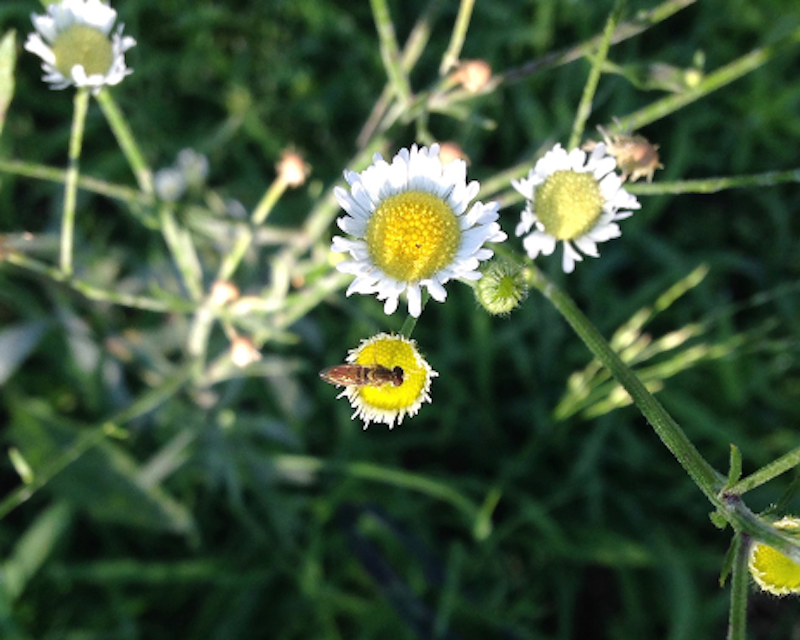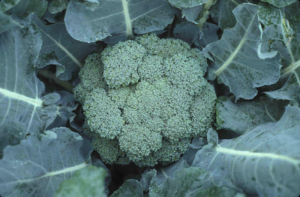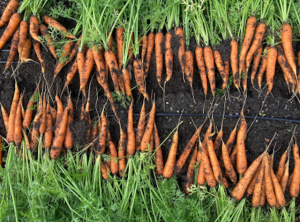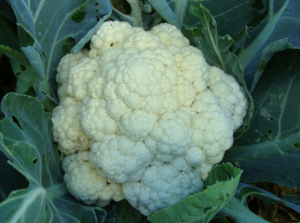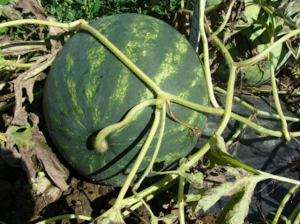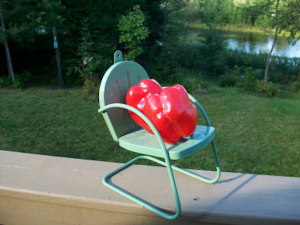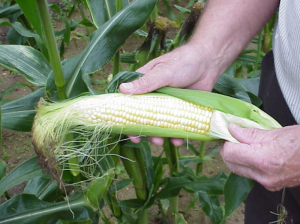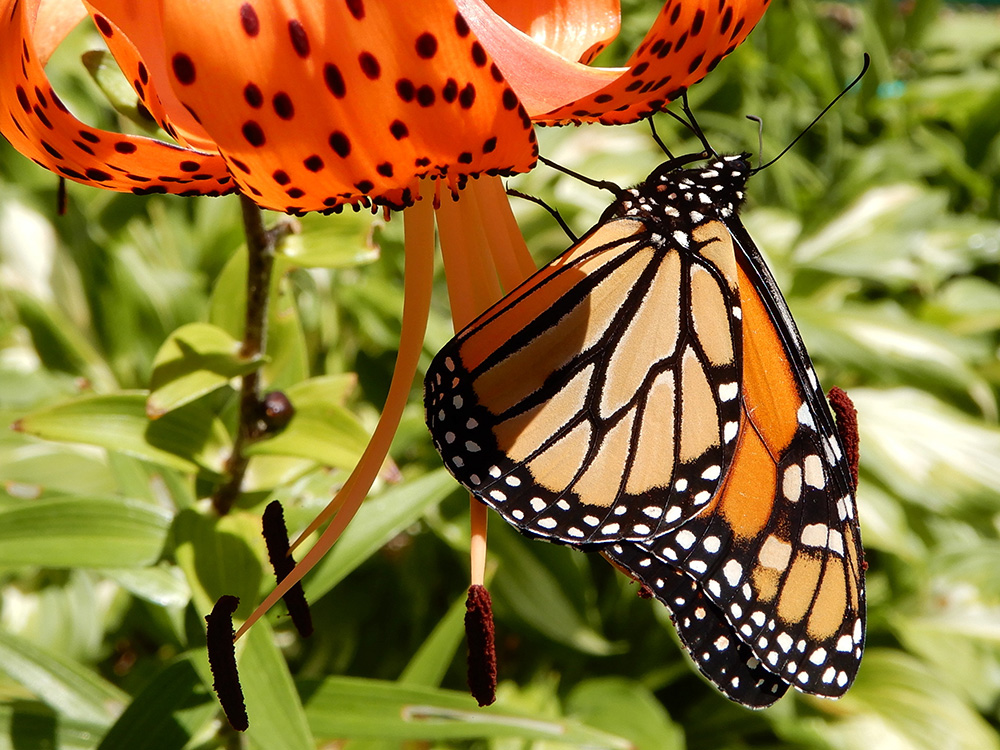
Maine Home Garden News – August 2022
In This Issue:
- August Is the Month to . . .
- Tree Swallows
- Insect Insights: Syrphid Flies
- August Maine Garden Harvest Guide
- Book Review: Celia Planted A Garden: The Story of Celia Thaxter and Her Island Garden
- Maine Day of Giving – Thank you!
August Is the Month to . . .
By Abigail Griffith, Horticulture Assistant, UMaine Cooperative Extension
August is a time to enjoy the rewards of all your hard work! Sip some lemonade and appreciate your garden. Then do some stretches and dive back in because staying on top of things now will set you up for success into the fall and next season!
Share your harvest! Dealing with a bumper crop of something? Donate surplus produce to your local food pantry. Call ahead to be sure they can handle it (some don’t have cold storage) and find out when you can drop it off.
Visit your garden frequently. If you are going out of town this August, have a friend or neighbor check on your vegetable garden and “help you stay on top” of beans, cucumbers, peas, zucchini, and summer squash that will require harvest at least twice a week once they come on. If left unchecked, you risk having tough, watery, or oversized low-quality fruit. Refer to August Maine Garden Harvest Guide.
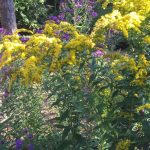
A friendly reminder about goldenrod: Goldenrod’s beautiful yellow blooms are often blamed for seasonal allergies, as we see them everywhere. Seasonal allergies are usually caused by breathing in pollen grains in the air from wind-pollinated plant species that create loads of lightweight pollen that stay airborne for days. The flowers are inconspicuous as they are not built to attract pollinators. They just make pollen and let it blow. Ragweed blooms at the same time as goldenrod and does just this. Meanwhile, goldenrod relies on insect pollination, with showy blooms to attract heavier, sticky pollen that does not blow around in the wind. Goldenrod also supports a tremendous variety of insects and acts as a host plant to 124 species of butterflies and moths in our region. For more information see, Blame Ragweed not Goldenrod for Your Hayfever.
Have you harvested your garlic yet? Once the bottom 2 or 3 leaves of your garlic plants have turned yellow, you can start pulling. Cure and save the best heads to be used as seeds to plant this fall. See Bulletin #2063 Growing Garlic in Maine.
Don’t let weeds go to seed! Even if your garden is cranking along, any weeds left to go to seed will leave an enormous amount of seed and future weeds for you to contend with next season. Even one weed left to go to seed can deposit thousands of seeds in your “seed bank” for next year.
Lawn care. Late August into early September is an optimal time to seed your lawn. The late summer’s warm days and cool nights are ideal for strong seedling growth, and there is less weed competition in late summer than in spring. These facts sheets: Bulletin #2367, Establishing a Home Lawn in Maine, Bulletin #2243, Maintaining a Home Lawn in Maine, and Bulletin #2166, Steps to a Low-Input, Healthy Lawn are great resources. Or, maybe you want to start getting rid of the areas of your lawn that are hard to care for and plant native groundcovers, shrubs, or wildflowers. Contact your local Cooperative Extension Office or check out Wild Seed Project for more information.
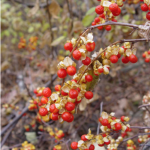
Keep an eye out for invasive plant species. Keep educating yourself about what to look for and make knocking them back part of your gardening chores. Don’t let that bittersweet go to seed—even just lopping the vines at the ground, so it doesn’t set seeds, is better than nothing. More information can be found here: Invasive Species: What and Where.
Have you seen any hornworms on your tomatoes? As you scout your garden for pests, keep an eye out for hornworms on your tomatoes, and pick them off. They are well camouflaged so look for defoliated areas on your tomatoes or their distinct droppings, which resemble small grenades! Check out the Extension’s Insect, Tick, and Plant Diseases resources to educate yourself on what you may be encountering in your garden.
Order your spring-flowering bulbs. Maybe try something new or prepare an area for some early spring color! You can even tuck them under deciduous trees, as they will bloom before the leaves come on. This is the time to get your orders in for a fall planting! Check out The Culture of Spring Flowering Bulbs for more information. For inspiration, Spring Flowering Bulbs, from the University of Illinois, includes suggestions like showy, whimsical alliums!
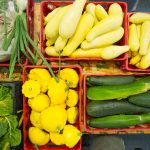 Plant crops for fall harvest. Spinach, lettuce, kale, and other brassicas do well with shorter day lengths. Fill in your empty spots by direct seeding greens or transplanting now. Refer to this chart for guidance.
Plant crops for fall harvest. Spinach, lettuce, kale, and other brassicas do well with shorter day lengths. Fill in your empty spots by direct seeding greens or transplanting now. Refer to this chart for guidance.
Preserve the best of the harvest. There’s nothing better than cracking open preserved vegetables from local farmers or your own garden. Check out Cooperative Extension: Food Preservation for instructional videos, workshops, and more!
Tree Swallows
By Doug Hitchcox, Maine Audubon Staff Naturalist
A welcome and familiar sight near summer fields and wetlands across North America, Tree Swallows are clever aerialists with deep blue iridescent backs and stark white undersides. These birds are often found zipping through the sky in a series of acrobatic twists and turns while catching and feeding on insects. The Tree Swallow—which is most often seen in open, treeless areas—gets its name from its habit of nesting in tree cavities; they are even known to inhabit human-made nesting boxes as well. During August these birds begin their long migration back to South America, congregating in enormous flocks. Watch for these growing migratory groups, especially along coastal dunes, over the next few weeks!
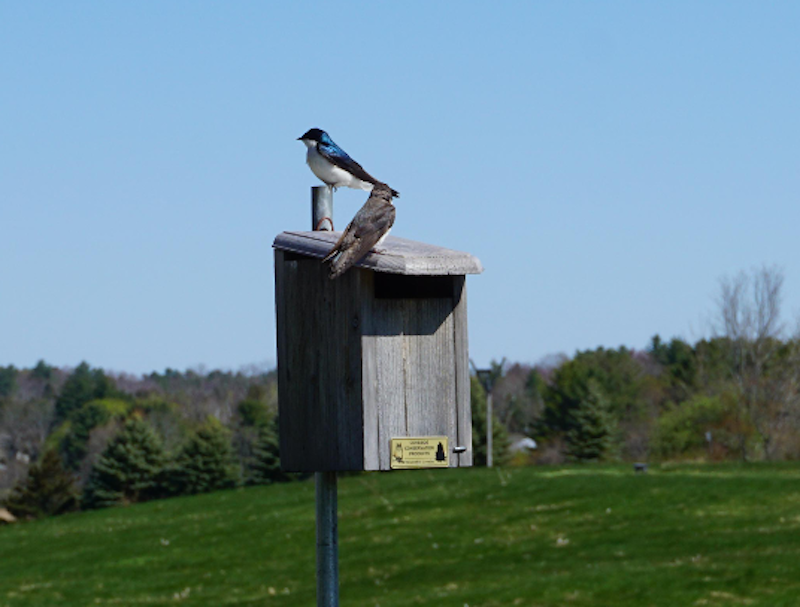
For more on the importance of Maine native plants to support birds and other wildlife, visit Maine Audubon’s “Bringing Nature Home” webpage.
Insect Insights: Syrphid Flies
By Renée Burkett, York County Master Gardener Volunteer
(More than 870 species in N. America.) Also known as hover flies or flower flies, these clever wasp and bee mimics are lovely little beneficial in your garden. Not only are they fun to watch as they hover and zip around, but these nondescript little garden friends also eat aphids during their maggot-like larval stage AND are terrific pollinators as adults. They don’t sting or bite, so enjoy watching their acrobatics as they work for you and your plants.
To learn more, check out:
- Flies: The Natural History and Diversity of Diptera by Stephen A. Marshall (Firefly Books, 2012)
- Syrphid Flies (hover flies, flower flies)
- Syrphid Flies (Flower/Hover Flies)
August Maine Garden Harvest Guide
By Abigail Griffith, Community Education Assistant; David Handley, Small Fruit Specialist; and Kate Garland, Horticulture Professional
Reviewed by Naomi Jacobs, Master Gardener Volunteer
Harvesting produce at its peak is the best way to achieve optimal flavor, shelf life, and overall quality. Additionally, many crops have improved yields if harvested in a timely manner. Determining the best time to harvest is not always intuitive, but can be simple with a little guidance. This season, we’re offering practical crop-specific harvest tips for the home gardener each month. Additional growing information can be found in the resources linked after certain crops.
- Broccoli: Harvest broccoli when the heads reach a usable size (anywhere from 3 to 8 inches), but more importantly, while the flower buds are still tight and unopened. Broccoli needs to be harvested promptly once mature, as it does not hold its quality. You can also harvest any side shoots that grow after you have taken the head.
- Cabbage: Harvest cabbage when the heads are a usable size, solid, and firm. A curling head leaf indicates the maximum size has been achieved. At this point, the head is very susceptible to splitting.
- Carrots: Check the days to maturity for your seed, which will give you a rough estimate of when to start checking your carrots for size. Harvest when they have reached the size you want. Once fully sized, roots should be harvested, otherwise, they are prone to splitting.
- Cauliflower: Harvest cauliflower when it reaches a usable size and before the buds open, usually about 6 to 8 inches in diameter. Heads are overmature when they have a coarse appearance or individual florets can be seen. At this point, the quality rapidly deteriorates.
- Eggplant: Harvest eggplant when the fruits reach a usable size and, most importantly, while still bright and glossy. Once the eggplant loses its glossy appearance, the seeds are starting to mature and the flavor will be off.
- Onions: For fresh use, harvest any time. If growing for storage, wait until roughly 60–70% of the tops have fallen over and the outer skin appears dry.
- Muskmelon: As the melon matures, the rind color will turn from green to a yellow/straw-like color; the ribs may still be green. Inspect the area where the peduncle (stem) attaches to the fruit for an abscission layer (indicating that the stem is pulling away from the fruit). Muskmelon tends to have good flavor and texture when the stem slips from the melon with firm pressure, or at “half slip.” The melon is not ripe if the stem has to be forcibly separated from the fruit. If the fruit just falls off, at “full slip,” it may be overmature. You may have to play around with the timing and level of slip depending on your variety.
- Watermelon: Where the peduncle (stem) attaches to the vine, there is a tendril. A dried tendril as shown in this picture is one of three indicators of a matured watermelon. The other two are a yellowed spot where the melon has been making contact with the ground and a deep, hollow thump when you knock on the melon.
- Pepper, sweet: Harvest sweet peppers when they reach full size and the fruit walls are firm. You can pick them green or allow them to ripen further for yellow, red, orange, or even purple peppers, depending on the variety. Pick as soon as they have changed to the color you want. Fully colored peppers are sweeter than green peppers but have a much shorter shelf life.
- Potatoes: Potatoes can be harvested as soon as they begin forming new potatoes or as they mature. Determine the size of the tubers by digging into the side of the hills. For storage, dig potatoes after the vines have died, the tubers are full sized, and the skins are mature. Storage potatoes should be cured at 60–70 degrees for a couple of weeks before being moved into cooler storage (45–50 degrees) for the long term.
- Sweet corn: Sweet corn is usually ripe approximately 20 days after it silks. Ripe ears have dried silk and are full to the touch. You can pull back the leaves to check that the kernels are plump. Kernels will squirt a milky liquid when punctured, indicating ripeness as well.
Fennel
Harvest bulb fennel when the bulb is about the size of a tennis ball and firm. Harvest before bolting.
Garlic
Garlic is planted in the fall and picked the following year, usually June–July. Harvest when the lower 3 or 4 leaves are drying and turning yellow.
Okra
Harvest when pods are 2 or 3 inches long. Larger pods tend to get hard and fibrous. Pick every couple of days to encourage continued fruiting.
Honeydew melon
Indications of ripeness vary across varieties, but common indications include changes to the rind color, turning pale yellow, especially on the underside, and a sweet smell. Ripe and over-ripe fruit is very susceptible to cracking, especially after rain.
Tomatillos
Tomatillos are ripe when the fruit fills the husk but is still green and firm. Once the fruit yellows, it is over ripe and will lose its flavor. If the fruits fall off the vine before they ripen, you can gather them and store them in their husks until they are ripe.
More information:
- Growing Broccoli in Home Gardens
- Growing Cabbage in Home Gardens
- Growing Carrots in Home Gardens
- Growing Cauliflower in Home Gardens
- Growing Eggplant in Home Gardens
- Fennel, Foeniculum vulgare
- Growing Garlic in Maine
- Watch Your Garden Grow, Orka
- How to Harvest and Store Onions (video)
- Growing Peppers in the Home Garden
- Growing Potatoes in the Home Garden
- Growing Sweet Corn in Home Gardens
- Growing Tomatillos and Ground Cherries in Home Gardens
See our:
- Maine Home Garden News June issue for more information on harvesting asparagus, beets, lettuce, radish, rhubarb, spinach, Swiss chard, and turnip
- Maine Home Garden News July issue for beans, cucumber, kohlrabi, parsley, and peas
Book Review: Celia Planted A Garden: The Story of Celia Thaxter and Her Island Garden
Phyllis Root & Gary D. Schmidt, illustrated by Melissa Sweet
Candlewick Press, 2022
Grade level: Kindergarten–4th grade
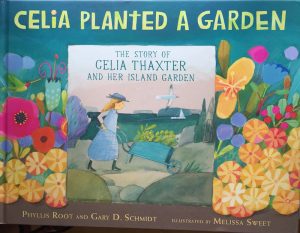
This children’s picture book introduces readers to Celia Thaxter (1835–1894) and her garden on Appledore in the Isles of Shoals, about seven miles off the coast of Portsmouth, NH. Celia Thaxter’s garden gained some notoriety when American Impressionist Childe Hassam painted views of it, though Thaxter was better known during her lifetime as a poet.
The book follows Thaxter from childhood to adulthood. Although she spent her early years on remote White Island in the Isles of Shoals, when she was 12, her family moved to Appledore, where her father built and operated a hotel. Besides providing hospitality to the summer visitors, who included Longfellow, Hawthorne, and other literary figures, Celia planted a garden. Over the decades, her garden grew and flourished on this harsh, rocky island.
Children will enjoy anecdotes that punctuate the book — leading the family cow into the kitchen during a fierce winter storm and helping to revive a partially frozen hummingbird.
Many parents of young children are familiar with the picture book Miss Rumphius by Barbara Cooney. Like Miss Rumphius, Thaxter rejoiced in the beauty of her flowers, but this book also provides biographical material about a notable American poet who is largely forgotten today.
“The very act of planting a seed in the earth has in it to be something beautiful,” wrote Thaxter in one of her journals. Maine illustrator Melissa Sweet uses an illustrative script to highlight quotes like this. Together with her charming watercolors, this makes a richly visual book, which is as colorful as a flower garden.
For readers curious about Thaxter, there is biographical information, a timeline, and a bibliography at the back of the book.
Maine Day of Giving – Thank you!
Earlier this spring UMaine held its annual Maine Day of Giving, which included a campaign to support Extension’s Master Gardener Volunteer program. Now that the final numbers have been tallied, we just wanted to share our gratitude once again. Nearly 150 donors gave more than $7,500 to support this community-centered program. Every year, hundreds of Master Gardener Volunteers spread across the state and use their gardening skills to create positive change in their communities. These talented volunteers work with students on school garden projects, teach workshops on making great compost, grow and donate produce to Maine Harvest for Hunger, and help beautify public spaces. Thanks to our generous donors, all of these community garden projects are sure to grow and thrive this year. Want to learn more about the MGV program? Check out our webpage…
Do you appreciate the work we are doing?
Consider making a contribution to the Maine Master Gardener Development Fund. Your dollars will support and expand Master Gardener Volunteer community outreach across Maine.
Your feedback is important to us!
We appreciate your feedback and ideas for future Maine Home Garden News topics. We look forward to sharing new information and inspiration in future issues.
Subscribe to Maine Home Garden News
Let us know if you would like to be notified when new issues are posted. To receive e-mail notifications, click on the Subscribe button below.
University of Maine Cooperative Extension’s Maine Home Garden News is designed to equip home gardeners with practical, timely information.
For more information or questions, contact Kate Garland at katherine.garland@maine.edu or 1.800.287.1485 (in Maine).
Visit our Archives to see past issues.
Maine Home Garden News was created in response to a continued increase in requests for information on gardening and includes timely and seasonal tips, as well as research-based articles on all aspects of gardening. Articles are written by UMaine Extension specialists, educators, and horticulture professionals, as well as Master Gardeners, Volunteers from around Maine. The following staff and volunteer team take great care editing content, designing the web and email platforms, maintaining email lists, and getting hard copies mailed to those who don’t have access to the internet: Abby Zelz*, Annika Schmidt*, Barbara Harrity*, Cindy Eves-Thomas, Kate Garland, Mary Michaud, Michelle Snowden, Naomi Jacobs*, Phoebe Call*, and Wendy Roberston.
*Master Gardener Volunteers
Information in this publication is provided purely for educational purposes. No responsibility is assumed for any problems associated with the use of products or services mentioned. No endorsement of products or companies is intended, nor is criticism of unnamed products or companies implied.
© 2022
Call 800.287.0274 (in Maine), or 207.581.3188, for information on publications and program offerings from University of Maine Cooperative Extension, or visit extension.umaine.edu.
The University of Maine is an EEO/AA employer and does not discriminate on the grounds of race, color, religion, sex, sexual orientation, transgender status, gender expression, national origin, citizenship status, age, disability, genetic information or veteran’s status in employment, education, and all other programs and activities. The following person has been designated to handle inquiries regarding non-discrimination policies: Director of Equal Opportunity, 101 Boudreau Hall, University of Maine, Orono, ME 04469-5754, 207.581.1226, TTY 711 (Maine Relay System).

